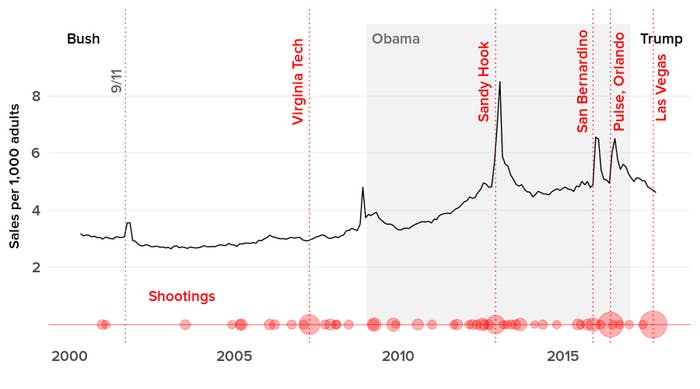Under President Donald Trump, a strong supporter of the Second Amendment, gun sales did not spike in the weeks since the Las Vegas mass shooting, according to a BuzzFeed News analysis.
This suggests that spikes after other recent prominent mass shootings were driven mainly by fear of new gun laws after President Barack Obama called for new controls. It seems there is some truth to one pundit’s claim that Obama was “the best gun salesman in America.”
Estimated gun sales

To make the chart, BuzzFeed News estimated gun sales from the FBI’s monthly figures on background checks for gun buyers, using a method developed by Jurgen Brauer, an economist at Augusta University in Georgia and the consultancy Small Arms Analytics & Forecasting. (See here for details of the analysis.)
Gun sales are highly seasonal, peaking each December. So we applied a correction method used by the US Census Bureau to remove seasonal trends, revealing any transient spikes in sales. These happened after: the murder of 20 children and 6 adults at Sandy Hook Elementary School in Newtown, Connecticut, in December 2012; the San Bernardino terrorist attack in December 2015, in which 14 people were shot dead; and the Pulse nightclub shooting in Orlando in June 2016, where 49 people died.
Sales estimates from the FBI’s data inevitably undercount the true total, because not all gun sales legally require a background check. But in California, where all gun purchases have to be reported to the state government, sales data tell a similar story. In a study published in May, researchers led by David Studdert of Stanford University found sharp peaks in handgun sales after the Sandy Hook and San Bernardino shootings. (They analyzed data from January 2007 to February 2016, so did not investigate sales after the Pulse nightclub massacre.)
Gun sales do not always surge after major mass shootings, however. On April 26, 2007, Virginia Tech student Seung-Hui Cho killed 32 people on the university’s campus in Blacksburg, in what was then the worst mass shooting in modern American history. Yet in the weeks that followed, there was no appreciable uptick in estimated gun sales.
In 2007, George W. Bush was in the White House — and any Congressional attempt to pass strict new gun control measures would have likely met his veto. But after Barack Obama won the November 2008 presidential election, gun buyers seemed to get nervous.
In what was seen as a damaging slip during his Democratic primary battle with Hillary Clinton, Obama had alienated many gun owners by saying that small-town voters “cling to guns or religion.” Before he took office, with potential gun buyers worried about the new president and a Democrat-controlled Congress enacting stricter controls, sales surged.
Each of the spikes that followed came in the weeks after Obama called for new gun laws in the wake of horrific mass shootings. And estimated gun sales seemed to gradually climb throughout his presidency, before subsiding when Donald Trump took office promising to protect gun ownership rights.
The peaks during Obama’s presidency led many experts, and a previous New York Times analysis, to conclude that the main driver of spikes in gun sales is fear of impending gun controls. “As soon as there’s the threat of legislation, even in particular states, you will see the background checks spike,” Brauer told BuzzFeed News.
A more general fear explains the other noticeable peak on our chart, immediately after 9/11. Personal protection tops the list of reasons given for gun ownership, so it’s not surprising that violent events that stoke fear across society may drive gun sales. “Fear of personal safety outstrips everything else,” Stanford’s Studdert told Buzzfeed News.
That may explain why the surge in handgun sales Studdert’s team recorded after the San Bernardino attack was larger in that city and surrounding neighborhoods, where the threat of violence will have been felt mostly strongly, than elsewhere in California.
Another factor, according to Studdert, is that in the wake of a mass shooting, supporters of the Second Amendment may buy more guns to affirm their political identity as gun owners. “It’s very difficult to tease apart,” he said.
Still, the new numbers indicate that fear of legislation has in recent years been a strong driver of sales spikes. That’s backed up by anecdotal reports of a surge in sales of “bump stocks,” devices used by the Vegas shooter to make his weapons mimic the rapid fire of machine guns.
Congress is now considering a ban on bump stocks, and even the National Rifle Association has said their legality should be reviewed.
CORRECTION
The chart has been corrected. An earlier version had errors in the line showing estimated gun sales. The conclusions of the story are unchanged.
